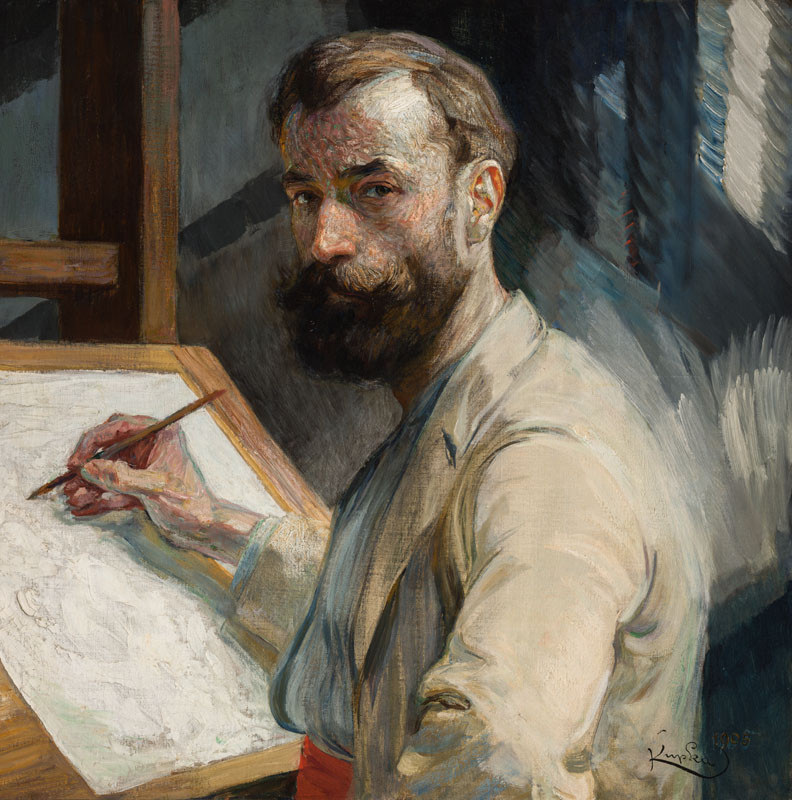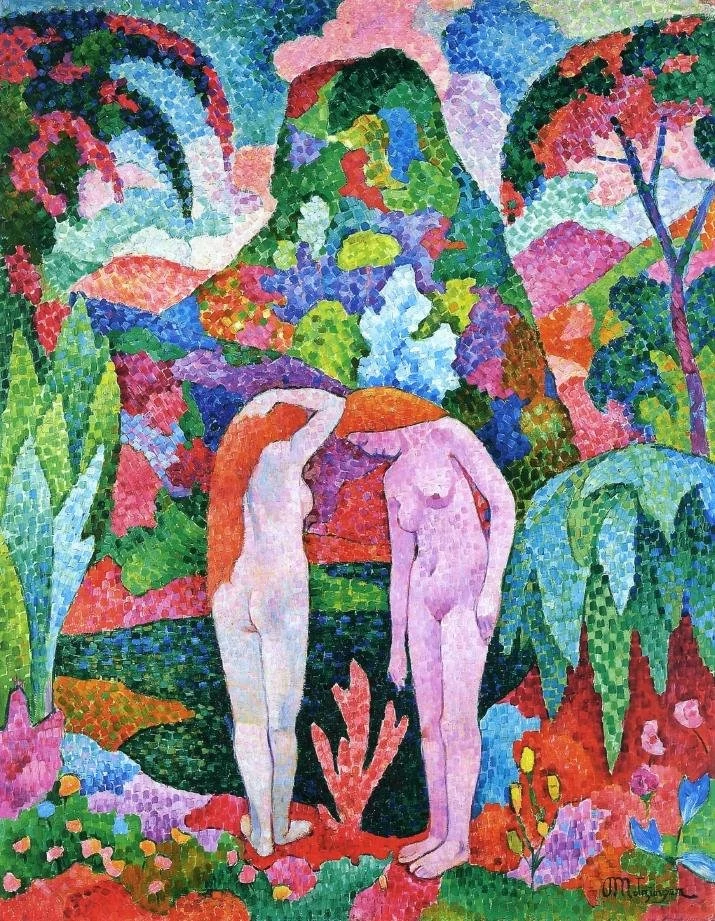RADIUM AGE ART (1905)
By:
February 23, 2024

A series of notes regarding proto sf-adjacent artwork created during the sf genre’s emergent Radium Age (1900–1935). Very much a work-in-progress. Curation and categorization by Josh Glenn, whose notes are rough-and-ready — and in some cases, no doubt, improperly attributed. Also see these series: RADIUM AGE TIMELINE and RADIUM AGE POETRY.
RADIUM AGE ART: 1900 | 1901 | 1902 | 1903 | 1904 | 1905 | 1906 | 1907 | 1908 | 1909 | 1910 | 1911 | 1912 | 1913 | 1914 | 1915 | 1916 | 1917 | 1918 | 1919 | 1920 | 1921 | 1922 | 1923 | 1924 | 1925 | 1926 | 1927 | 1928 | 1929 | 1930 | 1931 | 1932 | 1933 | 1934 | 1935 | THEMATIC INDEX.
Modern art makes itself known with two avant-garde schools, the Fauves in Paris and Die Brücke in Dresden.
The Third Salon d’Automne (Paris) features works by a group of Paris-based painters centered around Matisse — including Rouault, Derain, and de Vlaminck (also Braque, pre-Cubism). Because these painters share a passion for using raw and pure color pigments (straight from their tubes of paint) with which they decorated their primitive-style paintings, one critic was moved to comment “Donatello au milieu des fauves!” (“Donatello among the wild beasts”). Matisse’s Woman with a Hat, Manguin’s Siesta, Valtat’s Sailors, Vlaminck’s Seine at Marly — “a pot of paint has been thrown in the public’s face,” another critic says. Fauvism owed a significant debt to Impressionism’s vibrant colors; but Fauvists instilled a heightened sense of emotionalism into their paintings. The Fauves salute Van Gogh as the prophet of their ardor, their torments, and their exaltation.
Based in Dresden, beginning in 1905 the movement Die Brücke (Kirchner, Schmidt-Rottluff, Heckel, Nolde, Mueller, Pechstein, Van Dongen) combine traditional German art with African, Post-Impressionist and Fauvist styles. They hope to launch a revolt against refinement and rationalism in favor of the authentic expression of their strongest creative impulses. Arguably the beginning of the German Expressionist movement, though they didn’t use that term. The Brücke artists’ emotionally agitated paintings of city streets and sexually charged events transpiring in country settings made their French counterparts, the Fauves, seem tame by comparison. The group’s name — “The Bridge” — signified their desire to cross over into the future.

Kupka’s early work (see previous installments in this series) can be considered Symbolist, since he deploys demons, specters, mythical beings, and other exotica to evoke a sense of the soul’s unseen “inner life.” In 1905, however, Kupka began attending Sorbonne lectures on physics, physiology, and biology; he was now in search of “scientific” evidence for the existence of inner worlds. (Charles Henry, Director of the Laboratory of the Physiology of Sensations at the Sorbonne, was a French pioneer in the study of x rays, notes Linda Dalrymple Henderson.) Kupka was also a student of optics and perception. He’d note in his 1923 book Creation in the Plastic Arts that modern science was of great importance to modernist art.
In 1905, Čiurlionis begins the thirteen-panel cycle Creation of the World. “I have had the idea of painting it all my life,” he wrote. “This is the creation of the world, only not ours according to the Bible but some other fantastic world.” The Theosophical idea of a primeval field of energy spreading through the first movement of the universe is apparent here; see 1906.
Alfred Stieglitz and Edward Steichen open the Little Galleries of the Photo-Secession (later known as 291) photo art gallery on Fifth Avenue in New York City.
Maurice de Vlaminck is generally considered to be the first European to recognize the intrinsic value of African art. He tells of having noted in 1905, at a café in a Parisian suburb, two statues from Dahomey painted in red and yellow ochre and white and one from the Ivory Coast in black. A friend of his father’s later added to the collection a large white mask from the Ivory Coast. One day Matisse and Picasso happened to catch sight of the mask at Derain’s, and they were jolted by it. Picasso, the first to intuit what aspects could be extrapolated from the plastic concepts of African and Oceanian art, introduced these aspects little by little into his painting, an action that would contribute to Cubism’d development.
Picasso, who during the previous Christmas had frequently visited the circus installed on the Esplanade des Invalides, enters his so-called “Rose” or “Circus” period.
Gustave Le Bon was a French polymath whose areas of interest included anthropology, psychology, sociology, medicine, invention, and physics. In L’Évolution de la Matière (1905), Le Bon anticipated the mass–energy equivalence. His thesis that the production of all kinds of radiation was the result of the disassociation of the atom made him an important popularizer of contemporary physics. In his articles and best-selling books, Le Bon expressed his view that matter is simply “a stable form of intra-atomic energy” in the gradual process of disappearing into the ether.
Einstein formulates Special Theory of Relativity and establishes law of mass-energy equivalence; note however that Einstein’s theory will not reach the general public until after WWI.
As the second year of the massive Russo-Japanese War begins, more than 100,000 die in the largest world battles of that era, and the war chaos leads to the 1905 Russian Revolution against Nicholas II of Russia.
Baroness Emma Orczy’s play The Scarlet Pimpernel, the forerunner of her novel (and of fictional masked crusaders), opens at the New Theatre in London. Also, the popular fictional character Arsène Lupin, the gentleman thief, is introduced in France.
Mata Hari introduces her exotic dance act in the Musée Guimet, Paris.
Irish nationalist Arthur Griffith founds Sinn Féin in Dublin, as a political party whose goal is independence for all of Ireland.
Chinese revolutionary leader Sun Yat-sen forms the first chapter of Tongmenghui, a union of all secret societies determined to bringing down the Manchu dynasty.
The Wright brothers’ third aeroplane (Wright Flyer III) stays in the air for 39 minutes, the first aeroplane flight lasting over half an hour.
Death of Jules Verne.
See: RADIUM AGE: 1905

The painting records the scene in Venice after the collapse of the Campanille on July 14, 1902.

A catalog quoted in George Szabó’s 19th Century French Drawings from the Robert Lehman Collection: Catalogue (1980) notes the style and technique of this painting: “unusually combining two aspects — the decorative and the scientific.”

Snakelike vegetation invades a strange garden, seen through a ruined nave.

Between 1904–1907, Metzinger worked in the Divisionist and Fauvist styles, and created some of the first proto-Cubist works. He was both an influential artist and an important theorist of the movement. The idea of moving around an object in order to see it from different view-points is treated, for the first time, in Metzinger’s Note sur la Peinture, published in 1910. Metzinger, for the first time in this writing, discussed art representing objects as remembered from successive and subjective experiences within the context of both space and time. Metzinger and Albert Gleizes wrote the first major treatise on Cubism in 1912, entitled Du “Cubisme”.
During the First World War, Metzinger would co-found the second phase of the movement, referred to as Crystal Cubism. He recognized the importance of mathematics in art, through a radical geometrization of form as an underlying architectural basis for his wartime compositions.
In statement made circa 1907 regarding his mosaic-like Divisionism—where both size and direction of his cubes of color are fundamental to the rhythm of the painting—Metzinger cites parallels with Neo-Impressionism painters and Symbolist literature: “I make a kind of chromatic versification and for syllables I use strokes which, variable in quantity, cannot differ in dimension without modifying the rhythm of a pictorial phraseology destined to translate the diverse emotions aroused by nature.”




The Infernal Cave is a gorgeous film about Satan and the souls of the damned from 1905. Over the course of a few minutes, three whimsically costumed actors (Satan and two damned souls) dance around a flaming cave together. Satan then turns the two women into dust and sends them down into Hell. The magnificent coloring of the film makes it look like a painting of a fairy tale come to life.

Considered the masterpiece of Picasso’s Rose / Circus Period. Not *really* a fit for this series, but I do find this troupe to be a bit… alien-ish.
NOTES ON EXPRESSIONISM
In Dresden, German Expressionism was the cutting edge style, as practised by Die Brücke (1905-13). Note however that the term did not firmly establish itself until 1913; perhaps better to call these artists proto-Expressionist.
Expressionism would encompass a range of individuals and groups who moved in multiple directions away from the Naturalism and Impressionism of the nineteenth century toward a new style emphasizing personal expression and characterized by simplified or distorted forms and exaggerated color. It initially emerged in three distinct urban centers: Dresden, where the artists’ group Brücke was formed in 1905; Munich, where Vasily Kandinsky and Franz Marc established the group Der Blaue Reiter in 1911; and Vienna, where Oskar Kokoschka and Egon Schiele represented an Austrian strain of Expressionism that first emerged around 1908.
Expressionism emerged in various cities across Germany as a response to a widespread anxiety about humanity’s increasingly discordant relationship with the world and accompanying lost feelings of authenticity and spirituality. In part a reaction against Impressionism and academic art, Expressionism was inspired most heavily by the Symbolist currents in late-19th-century art. Vincent van Gogh, Edvard Munch, and James Ensor proved particularly influential to the Expressionists, encouraging the distortion of form and the deployment of strong colors to convey a variety of anxieties and yearnings.
Art was now meant to come forth from within the artist, rather than from a depiction of the external visual world.
The classic phase of the Expressionist movement lasted from approximately 1905 to 1920 and spread throughout Europe. See: Expressionism: A German Intuition, 1905–1920 (1980).
NOTES ON THE FAUVES
Fauvism, thanks to its dramatic and anti-natural color schemes, is considered the first real revolutionary art movement of the 20th century and the first public display of expressionism in France. Gertrude and Leo Stein were fans; they purchased Matisse’s garish Woman with a Hat.
MORE RADIUM AGE SCI FI ON HILOBROW: RADIUM AGE SERIES from THE MIT PRESS: In-depth info on each book in the series; a sneak peek at what’s coming in the months ahead; the secret identity of the series’ advisory panel; and more. | RADIUM AGE: TIMELINE: Notes on proto-sf publications and related events from 1900–1935. | RADIUM AGE POETRY: Proto-sf and science-related poetry from 1900–1935. | RADIUM AGE 100: A list (now somewhat outdated) of Josh’s 100 favorite proto-sf novels from the genre’s emergent Radium Age | SISTERS OF THE RADIUM AGE: A resource compiled by Lisa Yaszek.
